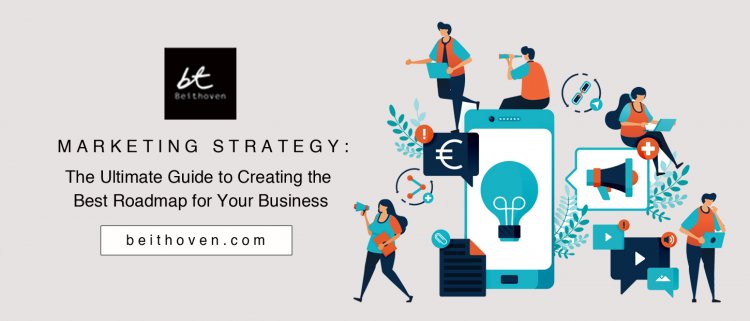Adapted from the original article at: https://beithoven.com/marketing-strategy/
“Tactics without strategy is the noise before defeat.” ~ Sun Tzu, author of ‘The Art of War’
So said Sun Tzu, a Chinese military strategist and philosopher, and writer of the immensely successfully ‘The Art of War’, an influential work of military strategy that has affected both the Western and East Asian philosophy and military thinking and also other industries such as business, marketing, law and government.
This quote cannot be further from the truth because if you do not have a concrete plan before you head into the complicated world of marketing, you are very likely going to waste your time, efforts and marketing dollars in activities that may not work for your business.
What Is a Marketing Strategy?
To prevent that from happening, you need to map out a marketing strategy before any execution. A marketing strategy is defined as the overall game plan of a business, a roadmap for your business to reach prospects and turn them into customers of your products and/or services. In brief, it should include an achievable and specific marketing-related goal or goals, your company’s value proposition, target audience, financial objectives and budget, as well as extensive research and conclusions on elements such as your brand, business and industry, competitors, and more.
What Do You Need to Include In Your Strategy?
Once you have understood the basics, your next task is to develop the actual strategy. Below is a very comprehensive framework that you can follow to develop a roadmap that can supercharge your business.
Part A: Research and Analysis
A1: Target Audience and Buyer Persona
Deciding on a target audience for your business is critical, as who your potential customers are will affect many important decisions that you need to make, such as the type of messaging, marketing platforms for promotion, and pricing strategy.
At this stage, you need to create a buyer persona, which is a fictional representation of your ideal client or target audience. It will be easier for you to create an effective strategy if you have a clear picture of who you are marketing to. You should create at least one buyer persona, or if you work with clients in different industries, you should create one buyer persona for each industry you serve.
- Maslow’s Hierarchy of Needs
You can also use Maslow’s Hierarchy of Needs model to expand on your target audience’s persona or profile. Proposed by American psychology Abraham Maslow in 1943, Maslow’s model is a motivational theory of psychological health that bases human decision-making on five hierarchical-level of human needs within a pyramid, with basic needs at the bottom and the more intangible needs at the top. We can move to address the higher-level needs when our basic needs are fulfilled. However, Maslow clarified that when a deficit need has been ‘more or less’ satisfied, it will be ‘removed’ in our minds, and our activities will be directed towards the next set of needs that we have yet to satisfy.
- Clayton Alderfer’s Existence-Relatedness-Growth (ERG) Theory
Clayton Alderfer’s ERG Theory builds on Maslow’s Hierarchy of Needs and states that there are three groups of core needs for humans:
- Existence (E) Needs: refers to basic material needs for living like physiological and safety needs (food and water, sleep, clothing, shelter, health, job security, protection from theft and violence, etc.)
- Relatedness (R) Needs: refers to the needs for maintaining interpersonal relationships, such as friendships and family bonds.
- Growth (G) Needs: refers to the needs for personal development such as self-respect and self-esteem, and other self-actualization needs from Maslow’s theory.
According to Alderfer, these needs may vary over time, and different individuals would prioritize the needs in different orders based on their life views.
- McClelland’s Human Motivation Theory
David Clarence McClelland, an American psychologist, proposed the Human Motivation Theory in the 1970s. This theory states that every individual has one of three main driving motivators: the needs for achievement, affiliation or power. All these needs are developed through his culture and life experiences, and affect his actions from a managerial context. This theory gives you a basis for understanding what motivates each individual, and how you can optimise your products and/or services to target him or her.
A2: Business Research and Analysis
At this initial stage, having a complete overview and understanding of your business makes it easier to develop a marketing strategy to accomplish your desired business goals. You need to look at a few elements, such as:
- Brand Analysis
Also known as a brand audit, it identifies how your brand will support or is supporting your marketing and sales efforts and how it is meeting or not meeting your customers’ needs. Ideally, you need to analyse whether there is a brand gap between your company’s brand strategy and reality, and identify areas of improvements.
- SWOT Analysis
SWOT stands for Strengths, Weaknesses, Opportunities and Threats, and so a SWOT analysis is a technique that you can use to assess these four aspects, so that you can determine the positioning of your business, and examine if it is aligned with your vision and goals. You can use the SWOT analysis on different cases, such as a new product launch, a sales campaign, or a marketing project.
In general, your strengths and weaknesses are the internal aspects of your business, and which you can control, including your staff, patents and intellectual property. Opportunities and threats are external, which you cannot control, and some examples are consumer purchase trends, competitors and the prices of raw materials.
- PEST Analysis or PESTLE Analysis
‘PEST’ stands for Political, Economic, Social, and Technological, and PEST analysis is a management method that a company uses to assess major external factors that influence its operations, and find out how these factors can create opportunities or threats to your business. Some of the elements that you need to look at include political, economic and social factors.
Sometimes, what we termed ‘PESTLE analysis’ can be used for a more extensive research, with two added components – Legal and Environmental, where you need to explore the legal and environmental landscapes by looking at the following elements that might impact your business.
- McKinsey 7S Model
The McKinsey 7S model, developed in the late 1970s by Tom Peters and Robert Waterman, former consultants at McKinsey & Company, is a useful framework for assessing an organisation’s well-being and future success, allowing you to look at its marketing capabilities from different points of view.
- Competitive Analysis and Research
A competitive analysis and research allows you to determine any current or future threats posed by competitors, and also gives you an idea of relevant market trends in your industry. This is a compulsory step before the strategic planning of your marketing roadmap because it ensures that you know what your competitors are doing, and help you gain a better understanding of your competitive edge in order to make better business decisions. It also ensures that the strategy you use later is powerful enough to surpass your competitors.
- Porter’s Five Forces
Porter’s Five Forces examines the competitive market forces in an industry or segment according to five elements: new entrants, buyers, suppliers, substitutes and competitive rivalry, all of which are the key forces that directly affect how much competition your business faces in an industry. This model is useful if your business is considering whether you should open up a new segment by expanding your products and/or services.
- Strategic Group Analysis
The Strategic Group Analysis framework let you analyse organisations in clusters based on the similarity of strategy. When you identified the cluster that your business falls into, you can check out who are your close competitors, and also get to understand the impact of different strategic approaches.
- Growth Share Matrix
The Growth Share Matrix, developed by the founder of the Boston Consulting Group in 1970, is a competitive analysis framework that classifies the products and/or services of your company against the competitive landscape of your industry. It helps you decide which products and/or services to invest in based on competitiveness and the attractiveness of each market.
- Perceptual Mapping
Perceptual mapping, or positioning mapping, is a visual representation of perceptions of your products and/or services relative to competing brands, products or services. You first decide two attributes you will use as the basis for comparison, and then plot where your products and/or services and those of your competitors should fall on the spectrum of these two attributes. This model is useful for understanding how your customers perceive your products and/or services as compared to your competitors’, in turn helping you to understand whether you need to tweak your existing positioning strategy in the minds of your target customers.
Part B: Defining the Marketing Strategy
B1: What Is the Value Proposition of Your Business?
A company’s value proposition forms the core of your competitive advantage, and let the customer understands why he should purchase a product and/or service from you instead of your competitors.
- Porter’s Value Chain Analysis
You can use Porter’s Value Chain analysis, a business management tool that was developed by Michael Porter, an American academic known for his theories on economics and business strategy, to uncover your business’ value proposition.
- The Golden Circle
You can also use the Golden Circle theory developed by Simon Sinek to differentiate the value proposition of your business, and explain why people and businesses are able to inspire others to act. It also explains how we respond best when messages communicate with these parts of our brain that control emotions, behaviours and decision-making. There are three parts to the Golden Circle:
- The Hedgehog Concept
Isaiah Berlin, a Latvian-born British philosopher, in his 1953 essay “The Hedgehog and the Fox”, divided the world into hedgehogs and foxes, based on the ancient Greek parable that states, “The fox knows many things, but the hedgehog knows one big thing.” According to Berlin, foxes pursue many goals and interests concurrently, and because of this, their thoughts are mostly diffused and not focused and hence their achievements are not impressive. On the other hand, hedgehogs just focus on one single objective, which is to defend itself, and it does so admirably with its spikes.
B2: What Are Your Business and Marketing Goals?
After you have defined the value proposition of your business, it is time to define your business and marketing goals because it is critical to have a system in place that will let you track and measure your results.
- SMART Goals
SMART, or Specific, Measurable, Achievable, Realistic and Timely goals is a set of goals used to help guide the goal-setting objective of your business. A clear definition of these parameters helps you ensure that your objectives are attainable within a certain timeframe, making it easier to track progress and identify any milestones or actions that you might have missed.
B3: Developing Your Branding Strategy
A branding strategy is a critical subset of your overall strategy because besides dictating your marketing strategy, it essentially sums up why your business exists at all, apart from making money. It is also the element that sets your business apart from the competition.
Part C: The Marketing Mix
C1: The 4Ps of Marketing
Neil Borden, a professor at the Harvard Business School of America, introduced the term ‘marketing mix‘, which refers to a set of marketing tools or actions that a business uses to pursue its marketing objectives in its target market. Later on, E. Jerome McCarthy, a marketing professor at Michigan State University, refined Borden’s concept and created the ‘4Ps’ – a mixture of four elements that make up the basis of a company’s marketing system – product, price, place and promotion.
- Digital Marketing Strategy
Creating a strategic planning roadmap to reach out to your prospective customers also includes the planning of a digital marketing strategy, probably the most critical part of your strategy today. An omnichannel digital marketing strategy will integrate technology and media across all possible platforms and channels. In a nutshell, your digital marketing strategy could include the following elements such as a social media marketing strategy, an influencers marketing strategy, and a content marketing strategy.
- Metaverse Marketing
With the advancement of virtual technologies and the recent rebrand of Facebook’s company name to ‘Meta’, metaverses will be the way to connect with consumers in time to come.
Brands are rushing into the metaverse, defined as an interconnected set of experiences in a collective virtual shared space for users to interact, created by a combination of augmented reality (AR), virtual reality (VR), social media, online gaming and some elements of cryptocurrencies.
The target market for metaverse marketing is mostly the Gen Zs and millennials (although I believe a decade later, the metaverse will become a norm to everyone), many of whom uses some forms of metaverses such as online games like Fortnite, Animal Crossing or Roblox, or VR and AR in their daily lives. If these people are your target audience, metaverse marketing is for you. You will need to understand these prospects and customers properly, and transition your marketing strategy from digital advertising and such to co-existing with your customers and prospects in a shared, virtual economy in the next decade.
- Traditional Marketing/Conventional Marketing
Traditional marketing, or conventional marketing, refers to conventional media that usually reach out to your audience offline. This includes broadcasting in the forms of television (TV) and radio (this has even been extended to digital radio nowadays), print advertising such as newspapers and magazines, outdoor advertising such as billboards, bus and taxi wraps and posters, direct mail, telemarketing and/or events.
Traditional marketing still works today because it is effective and scalable, though some elements may need a slightly higher investment than digital channels.
- Public Relations (PR) Marketing
Public relations (PR) refers to how your company communicates with your audience, be it your customers, partners, the media, and the general public. This is an important aspect of marketing, because it is also one of the best channels to build trust and establish a relationship with your customers. PR also refers to how your company manages your brand and communications, and this is especially important during a crisis.
C2: The 7Ps of Marketing (Service Marketing Mix)
Bernard H. Booms & Mary J. Bitner, both professors and marketing researchers, added 3 more Ps to the model in the late 1970s, calling it the Service Marketing Mix, and this can also be applied in service companies and knowledge intensive environments. The 3 Ps are people, processes and physical evidence.
The 8th P – Productivity and Quality
From the old service marketing mix comes an additional 8th P – productivity and quality. One important question you should ask is how you should manage your productivity and quality so that you can provide the best value to your customers.
C3: The 4Cs of Marketing
The 4Cs of marketing – Customer, Cost, Convenience and Communication – was proposed by Robert Lauterborn, a professor at the University of North Carolina, whose objective was to develop a new model that was more relevant in our modern business environment which will place a focus on unique target audience, unlike the 4Ps and 7Ps models which emphasized mass marketing.
The marketing mix, including the 4Ps and 7Ps of marketing, and the 4Cs of marketing provide possible frameworks that you can use to create or review your marketing strategy. Each element is equally important and needs an in-depth research to ensure that every one of them is developed effectively.
C4: Marketing Technologies (MarTech)
Planning a marketing strategy also needs the incorporation of marketing technologies, or martech, a range of software and tools, to help you optimise your marketing efforts across any marketing channels to achieve your marketing goals. Which technology will work best for your business depends mostly on who you are marketing to, such as, whether your your company is a B2B or a B2C organisation.
Some martech stack that you can consider for your business include software for marketing CRM, marketing attribution, marketing automation, email marketing, content writing and SEO, advertising management, social media management, customer experience, and video creation and hosting.
C5: Setting a Marketing Budget
No business can realistically survive in the long term without a marketing budget, so together with the planning of your marketing mix, you should also decide and allocate your marketing budget. Creating a marketing budget is one of the more important aspects of a marketing strategy that you should focus on, as it provides a financial roadmap that helps in your business’ decision-making process and allows you to more accurately determine your ROI for different segments of your marketing strategy.
A marketing budget should include all the expenses that you intend to spend on marketing-related activities over a specific timeframe, such as half a year, or a year. It can include expenses such as website creation, traditional advertising, digital advertising, content creation, public relations (PR), new marketing employees, hiring influencers, and buying new marketing software.
Part D: Analysis and ROI
Why did Napoleon attributed most of his military success to getting or having the right information? This is because when you are fighting for a competitive advantage in a sea of businesses with the same or similar products and/or services, having a good grasp of your marketing metrics and analytics data is critical to the success of your business goals. Hence, the final step after you have planned a marketing strategy is to measure its results. If you are not measuring and analysing your marketing results using marketing metrics and data, you will not be able to manage or optimise them, or to better manage your marketing budget.
It is never a good idea to implement analytics blindly. You need to develop a plan and an analytics strategy that specifies the long-term decisions your business makes about how you use your data to take actions that meet your objectives. Some marketing metrics that you can use include sales revenue, return on investment (ROI), return on advertising spend (ROAS) and Customer Lifetime Value (CLV).
The final step in analysis is to ensure that you always monitor your data, and also adjust them accordingly to maximise your ROI. This is important because you could be missing out on some key data that you need, or you may be collecting useless data for your purposes, or
With a strategy in place, every employee in your company would be on the same page and would know the steps that they need to take in order to reach the goals of the organisation. But putting together a successful strategy would not just happen overnight. In fact, it could be weeks or months of extensive research, brainstorming and planning, and there are many factors that must be considered. That said, every business is different, and every marketing strategy is different. An experienced strategist would be able to look at all the nuances of your business to pull together a scalable marketing strategy that would work effectively and efficiently to help you achieve your objectives. For the full article (a whopping 11,555 words), check out this link.























